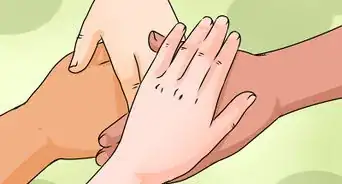This article was co-authored by Marissa Floro, PhD. Dr. Marissa Floro, Ph.D. is a Psychologist and Instructor at Stanford University’s Weiland Health Initiative and adjunct faculty at the University of San Francisco. Dr. Floro received her Ph.D. in Counseling Psychology from Loyola University Chicago, focusing on the intersections of race, attraction, and gender. Dr. Floro’s continued clinical, teaching, and advocacy work focuses on sexual and gender diversity, racial identity and belonging, and liberation from oppressive systems and structures.
This article has been viewed 11,125 times.
You've decided that the label "nonbinary" is for you, so what's next? Do you change your name? Do you change your style? This guide will help those who are new to the identity, as well as those who feel like they need a little help.
Steps
-
1Decide how you want to present yourself. For some nonbinary individuals, their identity refers mainly to the way they feel about their inner self, and for others their expression of the identity is as much as part of them as their inner values. Your clothing and appearance does not define your identity, but using it to express yourself can help you feel more comfortable with your own body.
- Depending on how comfortable you are with your body, you may want to wear a binder, breast forms, a gaffe, or a packer. These are all garments or items that are used by transgender people to alter their appearance temporarily, depending on what parts you have.
- Binders are used to make a person's chest appear flatter, while breast forms and a bra are used to augment it for those without them.
- A packer creates a "bulge" in the genital area, while a gaffe is used to "tuck" genitals for those who want a flatter appearance in that area.
- A person who previously wore more feminine clothing can begin to wear men's flannel, or cut their hair to feel more androgynous. A person who previously wore more masculine clothing can take more care styling and growing out their hair or using more jewelry to define themselves. In these ways you can express your identity without facing the discrimination of "appearing" transgender.
- Of course, if you want to go full throttle with the clothing change, that's totally valid. Just stay safe, especially if you're trying to look more feminine.
- Depending on how comfortable you are with your body, you may want to wear a binder, breast forms, a gaffe, or a packer. These are all garments or items that are used by transgender people to alter their appearance temporarily, depending on what parts you have.
-
2Choose whether you want to come out as nonbinary. For many, coming out to friends and family can help them accept themselves and feel happier in their everyday lives. For others, there isn't much need to explain their identity to other people; they never really "come out", but can kindly remind other people of their pronouns when necessary. Don't feel pressured to come out if you don't want to.[1]Advertisement
-
3Understand that sexuality is separate from gender identity. You don't need to label yourself with a sexuality that doesn't represent your gender. Instead you can refer to your sexuality by simply stating the genders you are attracted to. Research other sexualities and identities to help you understand yourself and learn about other people who are experiencing the same things.
-
4Decide if you'd like to change your name. This may be more or less desired depending on your own identity. You can use baby name websites to search for a name that more closely matches your gender. There are unisex names as well.
- Unfortunately, most countries in Western society only recognize binary genders when it comes to gender markers, and changing them usually requires proof of gender reassignment.
- It may cost money, often upwards of $100, to change your name legally.
-
5Determine your pronouns. Use any pronouns you feel comfortable with, and if you like multiple pronoun sets, don't limit yourself to just one. For example: a nonbinary person who's used he/him pronouns all their life might stick to those, or they might feel comfortable using he, she, or they to refer to themselves.
- Outside of the binary he/him and she/her, there are many non-binary pronoun sets, with the most popular one being the gender neutral singular they/them. People have also proposed new sets of non-binary "neopronouns", such as xe/xir and ne/nym. Some people use multiple sets of pronouns, others don't care which pronoun is used and others forgo pronouns altogether. You could have your pronouns as he/her/they if you felt like it!
Expert Q&A
-
QuestionWhat if I don't want my parents to know?
 Marissa Floro, PhDDr. Marissa Floro, Ph.D. is a Psychologist and Instructor at Stanford University’s Weiland Health Initiative and adjunct faculty at the University of San Francisco. Dr. Floro received her Ph.D. in Counseling Psychology from Loyola University Chicago, focusing on the intersections of race, attraction, and gender. Dr. Floro’s continued clinical, teaching, and advocacy work focuses on sexual and gender diversity, racial identity and belonging, and liberation from oppressive systems and structures.
Marissa Floro, PhDDr. Marissa Floro, Ph.D. is a Psychologist and Instructor at Stanford University’s Weiland Health Initiative and adjunct faculty at the University of San Francisco. Dr. Floro received her Ph.D. in Counseling Psychology from Loyola University Chicago, focusing on the intersections of race, attraction, and gender. Dr. Floro’s continued clinical, teaching, and advocacy work focuses on sexual and gender diversity, racial identity and belonging, and liberation from oppressive systems and structures.
Counseling Psychologist Maybe for now you can think about what it would be like to socially transition at school, and to maybe have that be different when you're back at home. There are always many options and many ways in which people can transition. It's a fluid process.
Maybe for now you can think about what it would be like to socially transition at school, and to maybe have that be different when you're back at home. There are always many options and many ways in which people can transition. It's a fluid process. -
QuestionWhat do I do if I'm not sure what pronouns or labels to use?
 Marissa Floro, PhDDr. Marissa Floro, Ph.D. is a Psychologist and Instructor at Stanford University’s Weiland Health Initiative and adjunct faculty at the University of San Francisco. Dr. Floro received her Ph.D. in Counseling Psychology from Loyola University Chicago, focusing on the intersections of race, attraction, and gender. Dr. Floro’s continued clinical, teaching, and advocacy work focuses on sexual and gender diversity, racial identity and belonging, and liberation from oppressive systems and structures.
Marissa Floro, PhDDr. Marissa Floro, Ph.D. is a Psychologist and Instructor at Stanford University’s Weiland Health Initiative and adjunct faculty at the University of San Francisco. Dr. Floro received her Ph.D. in Counseling Psychology from Loyola University Chicago, focusing on the intersections of race, attraction, and gender. Dr. Floro’s continued clinical, teaching, and advocacy work focuses on sexual and gender diversity, racial identity and belonging, and liberation from oppressive systems and structures.
Counseling Psychologist You can explore and try out different things you like. You don't have to be committed to a certain thing. You can change your label and your gender expression as much as you would like to.
You can explore and try out different things you like. You don't have to be committed to a certain thing. You can change your label and your gender expression as much as you would like to. -
QuestionDo you have to come out as nonbinary?
 Marissa Floro, PhDDr. Marissa Floro, Ph.D. is a Psychologist and Instructor at Stanford University’s Weiland Health Initiative and adjunct faculty at the University of San Francisco. Dr. Floro received her Ph.D. in Counseling Psychology from Loyola University Chicago, focusing on the intersections of race, attraction, and gender. Dr. Floro’s continued clinical, teaching, and advocacy work focuses on sexual and gender diversity, racial identity and belonging, and liberation from oppressive systems and structures.
Marissa Floro, PhDDr. Marissa Floro, Ph.D. is a Psychologist and Instructor at Stanford University’s Weiland Health Initiative and adjunct faculty at the University of San Francisco. Dr. Floro received her Ph.D. in Counseling Psychology from Loyola University Chicago, focusing on the intersections of race, attraction, and gender. Dr. Floro’s continued clinical, teaching, and advocacy work focuses on sexual and gender diversity, racial identity and belonging, and liberation from oppressive systems and structures.
Counseling Psychologist You don't have to come out unless you're ready. Many people find coming out to be fulfilling because they can gain acceptance for who they really are. However, it's totally normal to be nervous. Don't come out until you feel ready.
You don't have to come out unless you're ready. Many people find coming out to be fulfilling because they can gain acceptance for who they really are. However, it's totally normal to be nervous. Don't come out until you feel ready.
Warnings
- Be careful wearing a binder or gaffe. Make sure to wear them for less than eight hours if possible, and give yourself breaks.⧼thumbs_response⧽
- Be aware of how safe you are in your current environment. Those who face potentially abusive friends and family should have caution when coming out and expressing their gender identity.⧼thumbs_response⧽
References
- ↑ Marissa Floro, PhD. Counseling Psychologist. Expert Interview. 18 February 2021.































































